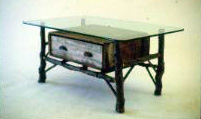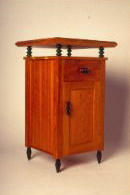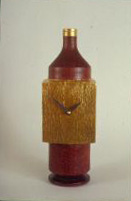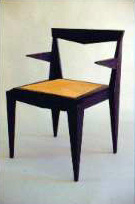
Carter Jason Sio had both the right teachers and the innate skill to become a highly respected furniture designer and builder, but he chose a very different path. Instead of crafting cutting-edge furniture to become the darling of the carriage trade, he opted to pass on his skill, vision and wisdom to the next generation.
For the past two decades, Carter Sio has taught woodworking at the prestigious George School, a Quaker academy in Pennsylvania renowned for having one of the finest high school woodworking programs in the nation. Had you looked in on Carter as a young man, though, you’d never have guessed he could ever end up here.
“I was an undiagnosed ADHD child who almost fell through the cracks,” Carter recounted. “I was struggling in school and getting in trouble with the law; breaking and entering, stealing cars and so forth. By age 16, I had flunked out of school. My sister, Hilary, had gone to George School and loved it, so my parents tried to get me in there. After their initial objections, the school agreed to accept me in 1973.” George School is a Quaker school which educates the whole person. Apparently that resonated with Carter, because he suddenly started doing very well.

“The one thing I had done really well in elementary school was sing, and I loved singing, but I had a hard time reading music. That was probably an early missed indication that I had a coding problem with my learning. I expected to be part of the chorus at George School, but the music teacher did not like the idea that I could not sight read, and he was hard on me about that, embarrassing me in front of the class. It soured chorus for me. The only class that was open as an alternative at that time slot was woodworking.
“The teacher at that time was the legendary Palmer Sharpless, who ran the woodworking program at George School from 1947 through 1983. He was the epitome of the perfect teacher, and was great at guiding students without intruding on their design. Palmer was also incredibly generous with his time, keeping the shop open long hours not only to students, but in the evenings for members of the surrounding community.” It is hard to travel in woodworking circles without running into people who talk about Palmer with reverence and gratitude.
“I took woodworking for three years, and did well both in the woodshop and in academics. While there, I made a [Wharton] Esherick style three-legged stool with a free-edged top and carved seat, and a [George] Nakashima style coffee table. I got a huge amount of pleasure from woodworking, and people let me know that I was good at it. Getting a positive reaction tends to have an impact on you.
“I left George School with lots of confidence, but tired of research papers that were read, graded, and put in a drawer. I wanted to be the person who made the drawer; made something that many people, not just one professor, would react to and appreciate. Though that was brewing in me then, the full realization did not come until I was in college.
“I went to Marlboro College in Vermont, majoring in anthropology, largely because my father is a famous anthropologist. Marlboro had a nice woodworking studio. By the time I had to declare a major, I realized that most of my fun and satisfaction was coming from woodworking, so I became a furniture making major, and more or less designed my own curriculum.

“In 1980, I took a year off to earn money working as a bartender, and applied to RISD [Rhode Island School of Design] and RIT [Rochester Institute of Technology]. I was accepted to both, but could not afford either of those two rather expensive colleges. I met Tage Frid, the famed woodworking program director at RISD, and he suggested I start making furniture instead of going to school.
“Meanwhile, my mother, a potter, was taking a class at Haystack [Mountain School of Crafts] and met Sam Maloof. He told her that he thought the two best schools for woodworking were not RISD and RIT, but rather the schools run by Wendell Castle and Ian Kirby. I met Ian, and loved what I saw. People there were really focused on making wood do what they wanted it to do instead of what it wants to do.”
“I went there for two years, and when Ian moved the school to Atlanta, he asked me to go along as his assistant, a non-paid position. That same year, I got a phone call from George School telling me that Palmer Sharpless was retiring, and that he suggested me as his replacement. I had just had an interview with Knoll International, a large furniture company, so I turned them down. However, when I told my father, he said ‘You at least need to go there and interview,’ so I did.
“The minute I set foot on campus, I started to feel it tugging me back. There is such a feeling of support, community, love and respect in that Quaker community. Meanwhile, Palmer was really leaning on me to take the job. By the time the interview was over, I knew that if they offered me the job, I would take it. They did, and I did.” That was 1984, and he’s been there ever since.

Every student at George School takes a full year of some arts-related class every year. That means that of the 540 students, Carter teaches from 60 to 80 of them per year. George School boasts a large, extremely well-equipped woodshop, much of which was his doing. “We replaced all the old benches and tools, and moved into larger quarters. Now there are two of everything, and nine Oneway lathes.” Under Carter’s tutelage, all the students make original designs.
“Most of my students are coming from an incredibly fast-paced life,” Carter explains. “The fact that they slow down enough to make a piece of original furniture that will last a lifetime, and possibly become an object of pride in their family, is a good thing to be doing. At least 10 of my students have gone on to become furniture makers, but even those who don’t will still become better consumers who appreciate quality and the time spent on making something by hand. The class affords a better appreciation for what goes into making something of beauty with your hands. It’s a worthwhile pursuit.”
Along with woodworking, he introduces his charges to the concept of stewardship. He is currently working bamboo into his curriculum because he likes how it looks in conjunction with solid wood, and likes the fact that it reaches maturity in four years. “The green aspect of it is really important,” Carter says. “I’ve always tried to teach responsibility, sustainability and respect for the materials. For example, one year we did a project where we only used pallets.”

When he can steal the time, Sio still designs and makes furniture, something made a bit easier by having access to such a fine woodshop. “There’s no denying that having a free studio space is alluring,” admits Carter. “We mill all our own wood here, and I have carte blanche. I have no doubt that I have THE best job at George School.
“It has been enough to feed me,” he says of his teaching, “but it does not come without some guilt that, considering all my education in the field, I’m not building furniture full-time.” When it comes right down to it, though, he sees a greater joy and a greater good coming from his teaching.
“I love getting kids hooked on working with wood. “I love watching kids handle wood and work it. There is something really special about helping others feel the excitement and rewards of making a piece of furniture.”





